Are you looking for a perfect indoor plant?
Then, you won’t regret checking out the list of top10 indoor plants mentioned in this article.
No doubt, there are several indoor plants. This may make it difficult to choose the right fit for your home. Since there are many aspects to consider, such as finding the right location, staying within a reasonable budget, pet safety, maintenance level, etc.
Nevertheless, you need not worry as all of your concerns are addressed in this article, helping you make a wise decision.
And not only these top 10 indoor plants will add instant greenery to your place but they also introduce some valuable health and mood-boosting benefits.
With that said, let us begin to freshen up your home with a natural air purifier,
Top 10 indoor plants in India
1. Peace lily (Spathiphyllum)
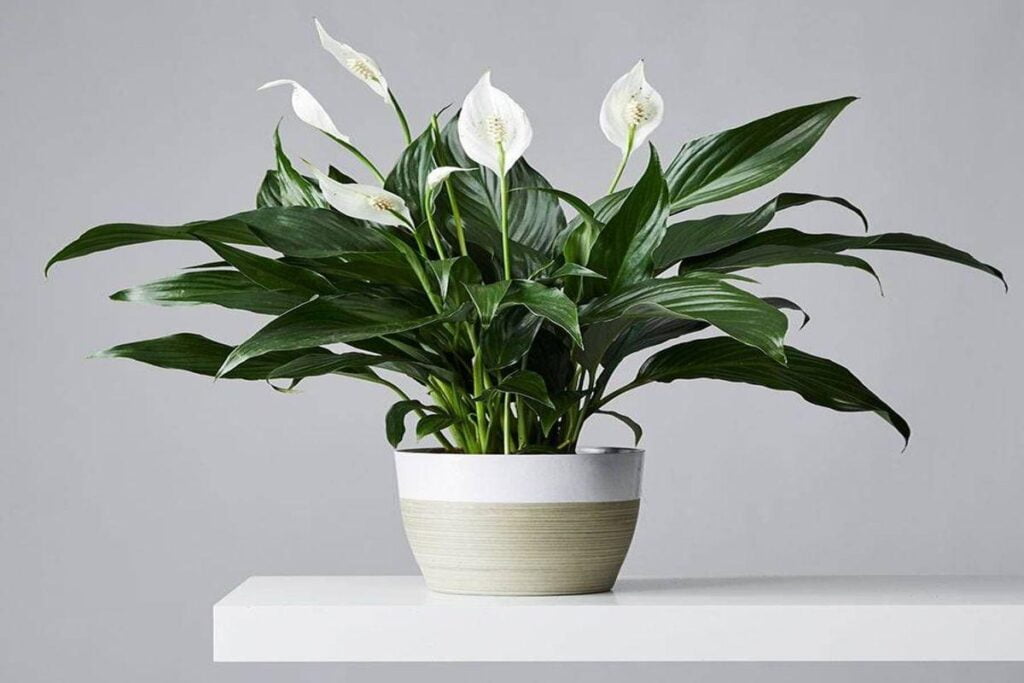
The peace lily has dark green glossy leaves with contrasting white teardrop-shaped flowers. In addition, it is tolerant of shade and easy to maintain. It is the best indoor plant for air purification. Removes high quantities of formaldehyde, benzene, trichloroethylene, xylene, toluene, and ammonia from the air.
Specifications
- Care level: Easy
- Price: Affordable
- Pet safe: No, mildly toxic if eaten
| Pros | Cons |
| A fantastic air purifier removes a wide range of toxic from the airEasy to care forThrive well in low light to bright indirect lightEnjoys the humidity in bathrooms or kitchens Perfect fit for the bedroom as it releases oxygen at night. | Toxic (mildly) for pets |
How to care for a peace lily?
The peace lily is the best indoor plant because it’s one of the best low-maintenance indoor plants. Unlike other plants where you might need to guess when you should water, the peace lily is incredibly helpful at communicating its needs by drooping dramatically when it needs water. Worry not! a quick hydrate and your peace lily will soon perk back up again.
Which is the best place for a peace lily at home?
Usually, most plants release oxygen during the daytime, but the peace lily continues to release oxygen at night, making it a great indoor plant for the bedroom. However, a peace lily will be happy almost anywhere in the house.
Therefore, it is useful for rooms that don’t get enough light, such as bathrooms or hallways. Moreover, this plant is happy in a shadier spot. It will be content in trickier north or east-facing rooms.
2. Parlour Palm (Chamaedorea Elegans)

The parlour palm has great aesthetic value with elegant arching leaf stems and an impressive freestanding habit that will add height to an interior; group several different sizes together to create a verdant display. This plant prefers bright indirect light, but as long as it has a spot out of the shade, it makes an easy-to-care-for indoor plant.
Specification
Care level: Easy
Price: Small plants are affordable; larger plants may get expensive
Pet safe: Yes
| Pros | Cons |
| Beautiful architectural leaf frondsSuitable for adding height to a room or group planting | Slow growing plant |
How do you care for a parlour palm?
The parlour palm prefers warm and humid climates. Moreover, this plant will thank you for a light misting on top of regular watering and for keeping it away from cold draughts or near radiators where it will dry out. So, find a comfortable spot and it will grow for many years.
How long does Chamaedorea Elegans take to grow?
This plant can reach up to 150cm in maturity, but it’s a slow-growing indoor plant so it won’t outgrow your home too quickly. This does mean larger plants can be expensive as they have taken years of care and effort to grow that tall. But smaller specimens are usually very affordable.
3. Flamingo Lily (Anthurium)

The Flamingo lily has a beautiful, long-lasting bloom of red, white, yellow, or striking black flowers. Moreover, its brightly colored leaf attracts wildlife in its natural tropical habitat.
Specifications
- Care level: Easy
- Price: Expensive
- Pet safe: No, the sap is toxic to the skin when ingested.
| Pros | Cons |
| Long-flowering blooms Architectural shape | ExpensiveToxic for pets |
How to take care of Anthurium?
This plant likes bright but dappled light. So, your Anthurium will be happiest if you place them in a room with a good light level but away from direct light. You can locate them a few meters away from your sunny window so that the direct sun rays will not fall on the plant.
Moreover, it likes moisture but not waterlogged soil and enjoys humidity. So, it is a good idea to do light misting with water now and then, or else you can do group planting to increase the humidity.
How often do Flamingo Lily blooms?
A healthy Flamingo Lily is likely to have around six spathe flowers a year. Each flower lasts for two-three months.
3. Snake Plant
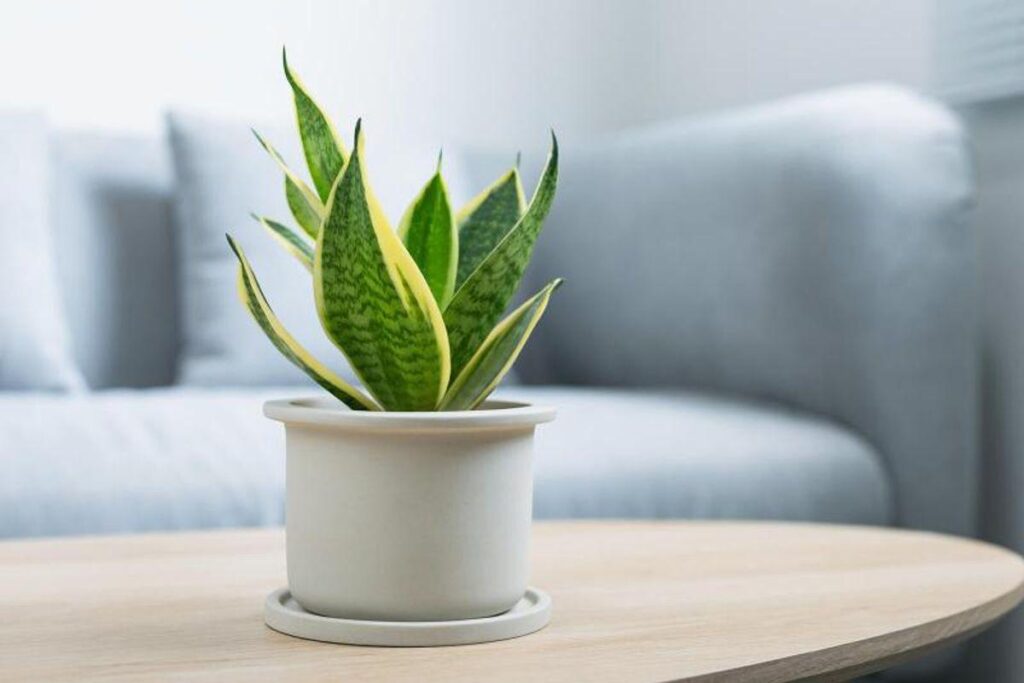
The Snake Plant is also known as “mother-in-law’s tongue.” This plant is widely used as an ornamental plant. In addition, it works as an excellent air purifier. Also, it is an easy-to-maintain indoor plant that grows well in low light, absorbs toxins and chemicals from the air, and converts carbon dioxide into oxygen.
Specification
Care: Easy
Price: Mild expensive
Pet safe: Mildly toxic to pets
| Pros | Cons |
| Air purifier Mental health booster Low maintenance ‘Unkillable’ indoor plantIdeal for houseplant beginners Architectural form Releases oxygen overnight | Slow growing plant Regular fungal attack Its sharply-pointed leaves are not good around children Cause irritation to the skin if you handle it without gloves |
How do I take care of the indoor snake plant?
Allow the soil to dry between waterings. Also, take extra care not to overwater the snake plant in winter. Avoid getting leaves wet while watering. And place your plant in indirect light, and during the growing season, fertilize the plant with all-purpose plant food.
How to know if my Snake plant is healthy?
A healthy snake plant has white and firm roots. If the snake plant’s roots are brown or black and they feel mushy, then your snake plant is succumbing to root rot.
How often Snake plant should be watered?
The snake plant is succulent, so it can tolerate droughts well. It makes quick recovery if you’ve neglected to water for a while. Snake plants generally prefer to be underwatered rather than overwatered. Also, follow the rule of less is more – a drink every few weeks in spring and summer, and less during the winter should be fine.
Do snake plants grow well indoors?
Yes, you can grow snake plants indoors and outdoors, with minimum maintenance required. Moreover, while grown indoors, the plant is the best air purifier. This quality of snake plant will keep you safe and healthy.
5. Money Plant

A money plant is the most popular Indian indoor plant. You can easily grow this plant in both soil and water. Moreover, the money plant is a great air purifier. And according to Feng shui practice, this plant creates a harmonious environment and brings prosperity.
So, if you are planning to grow money plants indoors, you have made a great choice to bring prosperity and harmony to your home.
Specification
Care: Easy
Price: Affordable
Pet safe: Yes
| Pros | Cons |
| Acts as an Anti-Radiator Air purifier Medicinal Benefits Brings Prosperity and Good Wealth | If not planted in the right direction, it may affect prosperity and wealth. (Avoid placing the money plant in the northeast direction) |
How to take care of an indoor money plant?
The money tree prefers deep but infrequent watering. So, water your money tree when topsoil is 50%-75% dry. Also, water your plant until it runs from the drainage holes and discards any excess water. And to prevent root rot, never keep your money tree in standing water.
How do money plants grow faster?
Keep the money plant near the window; the plant will grow towards the light. This plant loves solar light and thrives well in solar colors. So, keeping your money plant in daylight near a window will give it faster growth.
How to make indoor money plant bushy?
Take proper care of your money plant. Nurture and nourish the plant with proper amounts of sunlight, water, fertilizer, and timely pruning. This will make your money plant bushier, healthier, and heavier.
6. The Lucky bamboo plants
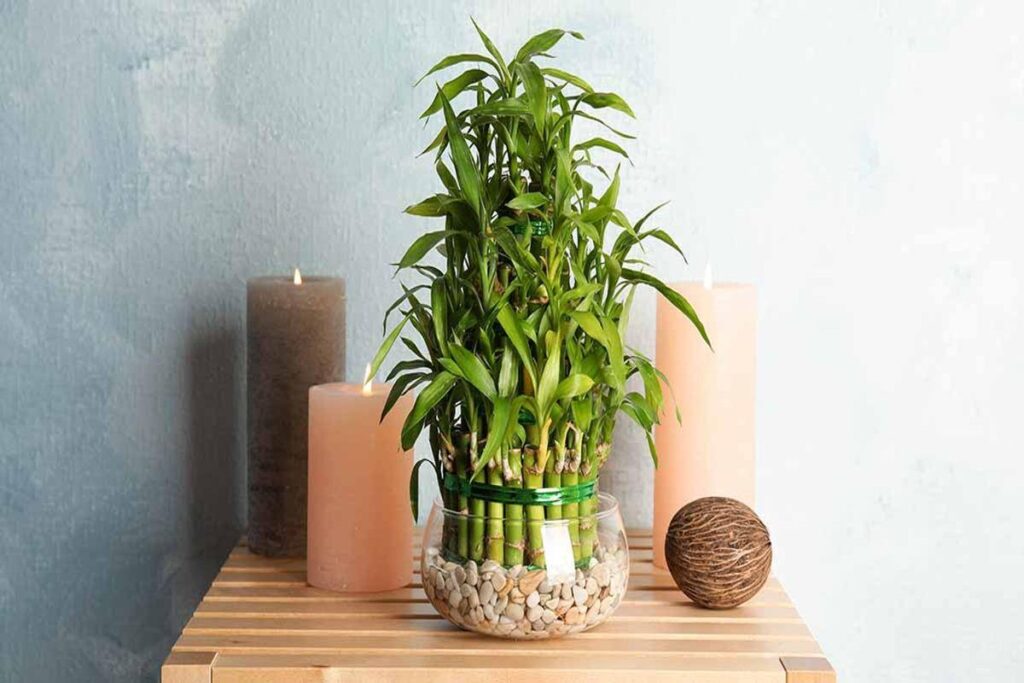
This indoor plant makes a regular appearance in Indian homes. If the lucky bamboo tree is placed by a window for indirect sunlight, it grows well. This plant can be grown in clean water (water needs to be changed every 2 weeks) and in soil.
Also, with some pruning, the lucky bamboo plant can be shaped in various organic forms for home decor.
Specification
Care: Easy
Price: Affordable
Pet safe: Yes
Fun fact: Foliage of bamboo contains up to 22% of protein, so it is good for them.
| Pros | Cons |
| Attracts wealth and prosperity to your home Stems of the lucky bamboo plant give an appealing look to the décor of any style of home. | Most lucky bamboo plant fertilizers contain chemicals that are harmful to your pets if ingested. |
Is a two-layer bamboo plant lucky?
The two-layer of the bamboo plant is an expression of love. The plant brings three kinds of luck to you: Happiness (Fu), Long Life (Soh), and wealth (Lu). It is also said that it doubles your luck in every aspect of your life.
Where to place lucky bamboo inside the home?
The ideal location to place the lucky bamboo plant is the east corner of your home. In addition, the southeast direction is favorable for the lucky bamboo plant.
How to take care of the Lucky bamboo plant?
Place Lucky bamboo plant in bright, indirect sunlight. Also, avoid keeping it in direct sunlight as it could burn the leaves. If you’re growing lucky bamboo in water, ensure there is always enough water in the container to cover the roots.
7. Aloe vera
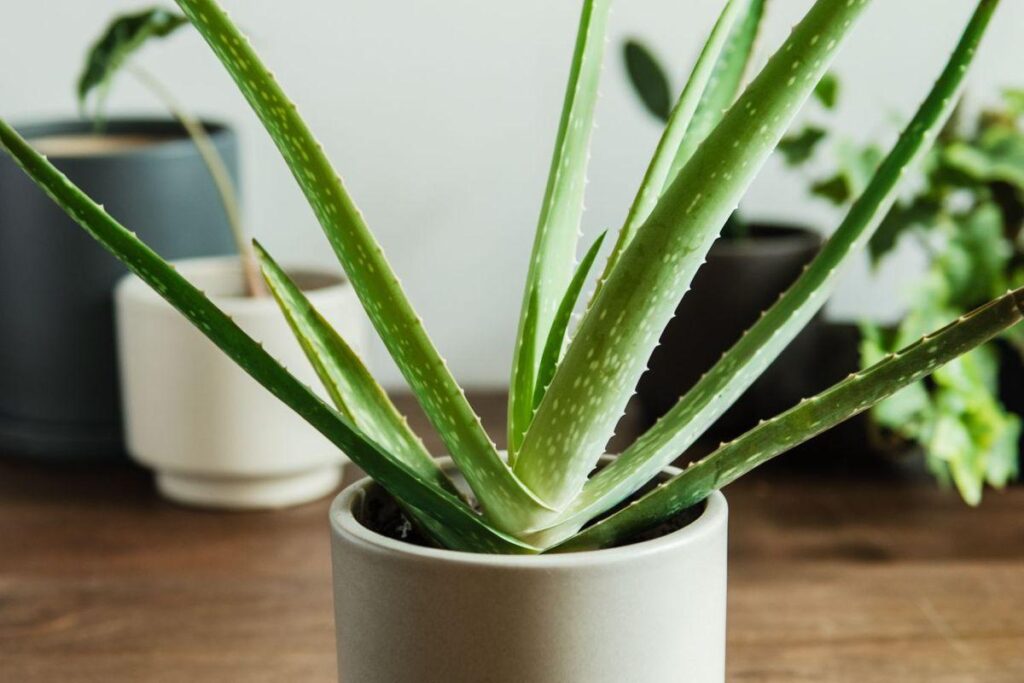
This succulent plant is easy to maintain. At once, it caters to health, beauty, and your home decor. Due to its several uses, the Aloe vera plant is fondly known as “the miracle plant”.
This ornamental plant needs a sunny window where it can enjoy enough light.
Specification
Care: Easy
Price: Affordable
Pet safe: Not safe for dogs
| Pros | Cons |
| Improves digestive health Promotes oral health Clears acne. Tolerant to bright direct light of a windowsill Its gel can be used to heal minor burns like sunburn | Sometimes when applied to the skin, it can cause burning and itching of the skin. Does not like the cold Fairly prickly leaves |
Does aloe vera grow well indoors?
This succulent plant is easy and attractive that makes for a great indoor companion. Also, aloe vera plants have many benefits. The juice from aloe vera leaves is used to relieve pain from scrapes and burns when applied topically.
Where should I place the aloe vera plant in my house?
Place aloe vera plants near a sunny window where they can receive enough indirect sunlight, such as a few feet from a south- or west-facing window. Also, remember too much bright, direct sunlight can brown its leaves. So, keep rotating the aloe vera pot once or twice a week so that all sides of the aloe receive equal lighting.
How to care for the aloe vera plant?
The aloe vera plant prefers plenty of light. It needs at least six to eight hours of bright indirect sunlight daily. Moreover, the aloe vera doesn’t require much water, preferring to dry out nearly completely between watering.
You need to keep them in a warm, draught-free space away from drafts – so try not to place them behind heavy curtains or on the windowsill where they can form a cold pocket on spring and autumn evenings.
8. Song of India Plant (Dracaena Reflexa)
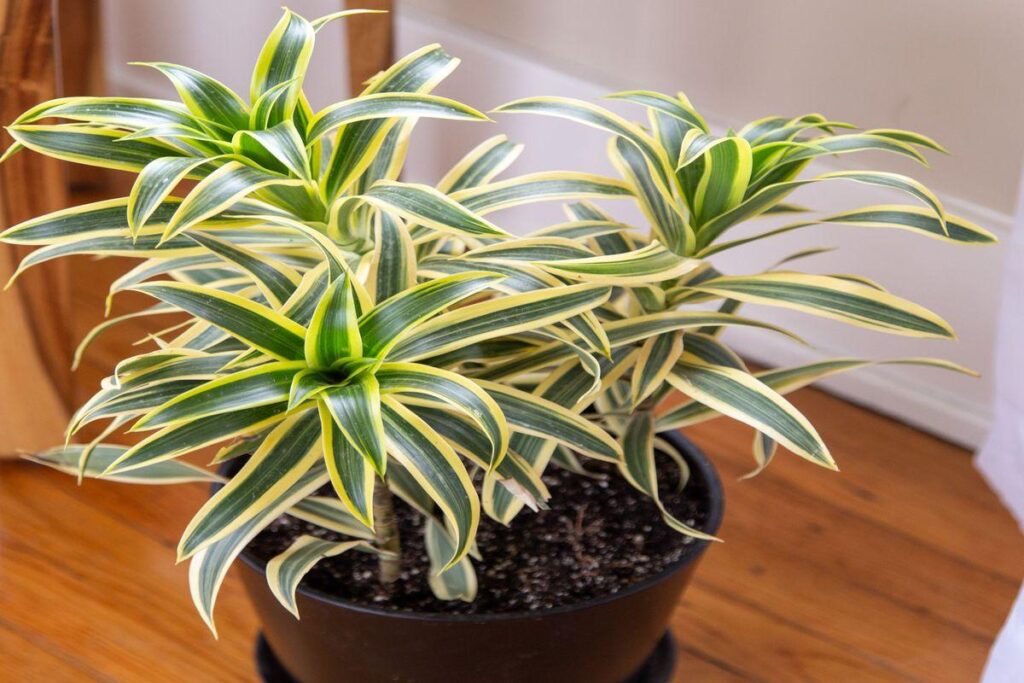
When placed on a side table or the mantel, this indoor plant brings a lively symphony of natural hues to your home. The Dracaena Reflexa has bright colored green, lime, and yellow leaves.
It is commonly known as “The Song of India”. This plant needs indirect sunlight and regular misting to keep its leaves vibrant.
Specification
Care: Easy
Price: Expensive
Pet safe: No. Toxic to dogs and cats
| Pros | Cons |
| Air cleaner Medicinal benefits Attractive plant | Slow growing plant Toxic to pets |
How to take care of the Song of India Plant?
The Song of India plants prefers indirect light and warm temperatures. They like humidity so you can set the container on top of a dish of rocks in the water, or you do mist regularly. Also, ensure the pot drains well and keep the soil moist but not wet. Moreover, provide a balanced fertilizer once or twice a year.
Why the plant is called “Dracaena Reflexa”?
The name of this genus is derived from the Greek word drakaina, which means a female dragon. Songs of India leaves are very popular in Hawaii because they look great in leis and tropical flower arrangements.
9. Ferns

Ferns are among India’s most commonly preferred indoor plants because of their green canopy of leaves. They like moderate levels of sunlight and moist soil to grow well. Regular watering and light spraying of the leaves will keep Ferns healthy and green.
Specification
Care: Easy
Price: Expensive
Pet safe: True ferns such as Boston Fern are non-toxic to dogs
| Pros | Cons |
| Minimal pests attack Filter toxins | Expensive |
Is it good to keep the Fern plant indoors?
Ferns are an excellent choice as an indoor plant. Its lush greenery will complement your flowering plants. Also, they can be grown in everything from clay pots to hanging baskets, and they do not need full sun to thrive.
How to Care for Fern plant?
Most ferns need high humidity levels to grow into green and lush indoor plants. There can be challenges in this regard, especially in areas where heat is provided by a furnace known to dry out the air inside. Also, keep this plant away from radiators and bright, sunny windows, and use a pebble tray to promote humidity.
10. Grape ivy

A hanging vine-like grape ivy can make a perfect pleasing addition to your home decor. This indoor plant is easy-to-maintain. They do fine even with low light, dry air, and minimal watering. In addition, Grape ivy helps in purifying the air and is also an ideal ornamental plant.
Specification
Care: Easy
Price: Expensive
Pet safe: Yes
| Pros | Cons |
| Provide antioxidant and anti-inflammatory benefits Purify the air | Expensive |
Is Grape ivy good for indoor conditions?
Grape ivy is a popular indoor plant since the 1940s. It is easy to care for. These plants are easy to grow, making them an excellent choice for potted houseplants and indoor hanging plants.
Is grape ivy a fast-growing plant?
Grape ivy is a charming and fast-growing vine with tiny hand-shaped leaves.
Conclusion
As if giving us health and happiness weren’t sufficient, the best indoor plants create a focal point in the room that’s both feel-good and visually appealing. They bring vibrant “aliveness” into your made spaces, providing plenty of greenery, the color known for its restful and relaxing properties.
Of course, for those who have small courtyards or balcony gardens, these indoor plants are the perfect fit to cover the space.
Feel free to share your experience with your indoor plant in the comment section!
Related Articles
- Propagating Chinese Elm Bonsai Cuttings And From Seeds
- Best Chinese Elm Bonsai Soil and Fertilizer.
- Troubleshooting Common Problems With Chinese Elm Bonsai
- Buy Chinese Elm Bonsai: How Not to Get Scammed When Purchasing a Chinese Elm Bonsai Tree!
- Chinese Elm Bonsai Pruning And Styling.
- Creating a Chinese Elm Bonsai Forest- Step-By-Step Guide.

